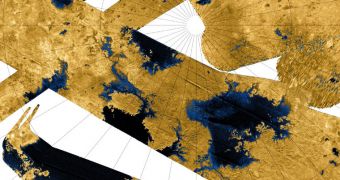Ever since the Cassini spacecraft made it into Saturn's orbit, back in 2004, it has observed that one of the gas giant's moons, Titan, features numerous and extensive lakes at its North Pole. The structures do not contain water, as temperatures there are simply too low to allow for that. Rather, liquid hydrocarbons such as methane and ethane probably make up most of the bodies, astronomers believe. At the same time, experts have noticed, the South Pole appears to house only a limited number of smaller lakes. The find may imply that life had the possibility to develop on the moon, NewScientist reports.
Astrobiologists say that, because of the natural satellite's orbital tilt, the northern lakes endured much more than their southern counterparts. This could mean that possible organisms may have had a lot more time to develop at the northern locations, astrobiologists reveal. We may be talking about time frames lasting for tens of thousands of years, rather than only a few dozens, as originally thought, the experts add. It may be that the appearance of the lakes was favored by changes in the gas giant's orbit as well, and not only by variations in Titan's.
According to California Institute of Technology (Caltech) expert Oded Aharonson, it may be that the lakes are very long-lived, and that they basically move between the two poles as Saturn changes its orbit. This may allow for potential early life forms inside them to develop for much longer time frames than initially thought possible, the scientist says. “The shear number of filled lakes in the north compared to the south is amazing,” planetary scientist Erika Barth, an expert at the San Antonio, Texas-based Southwest Research Institute (SwRI), explains. She has not been involved in the new study.
Another explanation for why the changes in the lakes' structures and distribution are not seasonal is the fact that there are a lot more empty lake basins at the North Pole. If the lakes had moved within one of Titan's years (about 29.5 Earth years), then the number of basins should have been roughly equal. Additionally, the depth of the lakes seems to argue against the seasonal explanation. Some of the structures are over 200 meters deep, and, during the course of a summer, only one meter of liquid hydrocarbons is added. Therefore, in a single season, the lakes could not be filled or drained completely.
The Caltech science team says that changes in Saturn's orbit make the Titan lake cycles last for about 45,000 years each, which is still a short time on the evolutionary scale, but enough to plant the seeds of life. And once these seeds appear, they learn to adapt to rough conditions, and endure.

 14 DAY TRIAL //
14 DAY TRIAL //